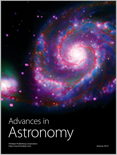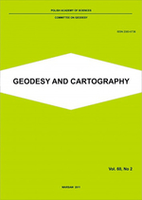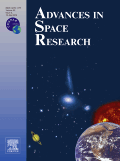
Artificial Satellites-Journal of Planetary Geodesy
Scope & Guideline
Pioneering Research at the Intersection of Satellites and Planetary Science
Introduction
Aims and Scopes
- Geodesy and Earth Observation:
Research in this area involves the use of satellite technologies and ground-based measurements to study the Earth's shape, gravitational field, and rotational dynamics, as well as monitoring natural phenomena. - Planetary Geodesy and Lunar Studies:
This scope encompasses the application of geodetic techniques to planetary bodies, focusing on lunar geology, resource assessment, and the implications for future lunar exploration missions. - Space Debris Monitoring and Mitigation:
The journal emphasizes the importance of understanding and managing space debris, with research dedicated to innovative capture methods and the implications for satellite operations. - Application of Advanced Computational Techniques:
The use of neural networks, simulation software, and statistical modeling in geodesy and space science is a key focus, highlighting the integration of technology with traditional methodologies. - Environmental Monitoring and Disaster Management:
Research aimed at using satellite data for monitoring environmental changes, such as flood dynamics and land use changes, contributing to disaster preparedness and management.
Trending and Emerging
- Artificial Intelligence in Geodesy:
The application of neural networks and AI techniques to improve geodetic modeling and data analysis is on the rise, indicating a trend towards more sophisticated computational methods. - Lunar Resource Utilization:
Research focusing on the potential for using lunar resources for construction and habitation is emerging, demonstrating a growing interest in sustainable extraterrestrial exploration. - Real-Time GNSS Applications:
There is an increasing trend in research related to real-time GNSS applications, reflecting advancements in technology and the need for immediate data processing in various fields. - Space Debris Management Innovations:
New methods for space debris capture and management are gaining prominence, highlighting the urgency of addressing space sustainability issues. - Interdisciplinary Studies Incorporating Earth and Space Sciences:
A trend towards interdisciplinary research that integrates concepts from both Earth and space sciences is emerging, fostering collaborative approaches to complex geodetic challenges.
Declining or Waning
- Traditional Geodetic Techniques:
There has been a noticeable decline in papers that focus solely on classical geodetic methods, as newer technologies and methodologies become more prevalent in the field. - Static GNSS Positioning Methods:
Research on static GNSS positioning techniques is decreasing, likely due to the increasing adoption of real-time and dynamic positioning systems that offer higher accuracy and efficiency. - Historical Geophysical Studies:
While historical data remains important, the focus on purely historical geophysical studies has waned, as contemporary applications and real-time monitoring take precedence.
Similar Journals

Reports on Geodesy and Geoinformatics
Exploring new horizons in geodesy and geoinformatics research.Reports on Geodesy and Geoinformatics, an esteemed scholarly journal published by SCIENDO, stands as a vital platform in the field of geodesy, geoinformatics, and related sciences. With an ISSN of 2391-8365 and E-ISSN 2391-8152, this open-access journal has been providing free access to impactful research and advancements in the domain since 2013. Located in Warsaw, Poland, at Bogumila Zuga 32A, Mazovia 01-811, it aims to disseminate high-quality research articles, case studies, and reviews that are crucial for academics, industry professionals, and students alike. The journal's commitment to promoting innovative methodologies and technological advancements reinforces its position as an important resource for fostering collaboration and knowledge sharing across global communities in geodesy and geoinformatics.

Space Science and Technology-Kosmicna Nauka i Tehnologia
Fostering collaboration in aerospace engineering and planetary science.Space Science and Technology-Kosmicna Nauka i Tehnologia is an esteemed journal dedicated to advancing knowledge in the fields of Aerospace Engineering and Space and Planetary Science. Published by the well-regarded PUBLISHING HOUSE AKADEMPERIODYKA in Ukraine, this journal serves as a vital platform for researchers, professionals, and students to share groundbreaking findings and innovative technologies related to space exploration and engineering techniques. Since its establishment in 2019, Space Science and Technology has contributed significantly to the academic discourse in its category, currently holding a Q4 quartile ranking in both Aerospace Engineering and Space and Planetary Science as of 2023. Although it does not offer open-access publication, its listed ISSN (1561-8889) and E-ISSN (2518-1459) ensure wide accessibility to its published content. As the journal continues its journey from 2019 to 2024, it strives to enhance its impact and H-index while fostering collaboration and knowledge dissemination across the global space science community.

Geofizika
Illuminating the Path of Earth Science ResearchGeofizika, an esteemed journal published by the Andrija Mohorovičić Geophysical Institute at the University of Zagreb, presents a significant platform for research in the fields of geophysics and Earth sciences. With an Open Access model established since 1984, this journal ensures that scientific knowledge is accessible to a broad audience, encouraging collaborations and the free exchange of ideas. Geofizika has steadily evolved through its converging years from 1989 to 1999 and has been active from 2003 to the present, reflecting its commitment to advancing geophysical research. The journal has been recognized for its contributions to Earth and Planetary Sciences and has acquired respectable ranks in various categories; notably, it holds a Q4 status in Geophysics as of 2023. Researchers, professionals, and students will find Geofizika a valuable resource for the latest discoveries and methodologies in geophysics, supporting the academic community in expanding the frontiers of knowledge in these vital scientific domains.

Advances in Astronomy
Pioneering Research in Astronomy and Astrophysics.Advances in Astronomy is a prestigious open-access journal published by HINDAWI LTD, dedicated to the field of astronomy and astrophysics. Established in 2008, the journal aims to disseminate significant research findings and advancements in the understanding of celestial phenomena, planetary sciences, and the intricate workings of the universe. With an impact factor that reflects its relevance in the scholarly community, Advances in Astronomy holds a commendable rank of Q3 in both Astronomy and Astrophysics as well as Space and Planetary Science categories, indicating its importance within these fields. The journal also showcases a commitment to open-access publishing, ensuring that research is readily available to both the scientific community and the public. Researchers, professionals, and students alike are encouraged to contribute to this dynamic forum to share knowledge and foster collaboration in exploring the wonders of the cosmos.

Boletim de Ciencias Geodesicas
Pioneering Discoveries in the Dynamic World of GeodesyBoletim de Ciências Geodésicas is an esteemed academic journal published by the Universidade Federal do Paraná within its Centro Politécnico. Focused on the dynamic field of Earth and Planetary Sciences, this Open Access journal has been a pivotal resource since 1997, fostering the dissemination of critical research and innovative methodologies. With an impact factor indicative of its relevance in the discipline, Boletim de Ciências Geodésicas ranks in the Q3 quartile for Earth and Planetary Sciences as of 2023, showcasing its commitment to quality scholarship in a competitive field. Researchers and students alike will benefit from access to cutting-edge findings, given its broad scope that encompasses various aspects of geodesy and related sciences. The journal's convergence of research from 2005 to 2024 ensures that it remains at the forefront of emerging trends and fundamental developments in the discipline, further enhancing its esteemed reputation in the academic community.

Chinese Space Science and Technology
Exploring the Frontiers of Space InnovationChinese Space Science and Technology is a pivotal journal dedicated to advancing the field of space engineering and technology, published by the esteemed Chinese Academy of Space Technology. With an ISSN of 1000-758X, this publication serves as a significant platform for cutting-edge research from China and around the globe, spanning vital intersections of Aerospace Engineering, Electrical and Electronic Engineering, and Materials Science. As evidenced by its Q3 ranking in 2023 across these categories, the journal consistently showcases innovative studies that contribute to the development of space technology, thereby impacting both theoretical frameworks and practical applications in the industry. Researchers and professionals will find valuable insights within its pages, while students can enrich their educational journey through its wealth of knowledge. Though primarily published in print, the journal continues to foster collaboration and engagement among the academic community, offering a glimpse into the future of space exploration and technological advancements through its relevant and timely content.

Advances in Geodesy and Geoinformation
Unlocking Geospatial Insights for a Global AudienceAdvances in Geodesy and Geoinformation is a pioneering journal published by the Polish Academy of Sciences, dedicated to the dynamic fields of geodesy and geoinformation. With an ISSN of 2720-7242 and an E-ISSN of 2720-7242, it offers an open-access platform since 2022, making cutting-edge research readily accessible to a global audience. The journal aims to foster the dissemination of innovative methodologies, technologies, and applications in the realms of geospatial data and earth sciences. Researchers, professionals, and students alike can benefit from the high-quality articles that contribute to advancing knowledge in this critical area, bridging theoretical insights and practical solutions. Situated in the heart of Poland, at PL Defilad 1, Warszawa, the journal not only reflects the nation's academic rigor but also positions itself as a crucial hub for international collaboration and knowledge exchange in geodesy and geoinformation.

Geodesy and Cartography
Pioneering Research in Geodesy and Geographic Information ScienceGeodesy and Cartography, published by the Polska Akademia Nauk (Polish Academy of Sciences), is a premier open-access journal dedicated to advancing the fields of geodesy, cartography, and geographic information science. Since its inception in 2010, the journal has provided a vital platform for researchers, professionals, and students to share their findings, fostering innovation and collaboration in these critical areas of study. With its ISSN 2080-6736 and E-ISSN 2300-2581, the journal is accessible to a global audience, ensuring that cutting-edge research is readily available to enhance scientific understanding and application. The journal not only serves as a repository of knowledge but also aims to contribute to the development of best practices and methodologies within geospatial sciences, making it an essential resource for anyone invested in the ever-evolving landscape of mapping and spatial data analysis.

Romanian Astronomical Journal
Advancing cosmic knowledge, one article at a time.Welcome to the Romanian Astronomical Journal, a distinguished publication operating under the esteemed EDITURA ACAD ROMANE, dedicated to advancing the field of Astronomy and Astrophysics. With a rich tradition rooted in Romania, this journal aims to foster scholarly discourse and disseminate pivotal research findings within the cosmic sciences. Although currently not designated as Open Access, the journal remains committed to ensuring that its content meets rigorous academic standards. The Romanian Astronomical Journal holds a commendable position in the academic community, achieving a Q3 ranking in Astronomy and Astrophysics and a Q4 ranking in Space and Planetary Science for 2023, reflecting its contribution to the scientific landscape. With a focus on originality and scholarly excellence, this journal serves as a vital resource for researchers, professionals, and students alike, promoting a deeper understanding of the universe and our place within it. Positioned at the intersection of innovative research and practical application, the Romanian Astronomical Journal invites contributions that push the boundaries of knowledge in our field.

ADVANCES IN SPACE RESEARCH
Advancing Understanding of the Universe.ADVANCES IN SPACE RESEARCH, published by Elsevier Science Ltd, is a leading journal in the fields of Aerospace Engineering, Astronomy and Astrophysics, Atmospheric Science, and more. Since its inception in 1981, this journal has dedicated itself to the dissemination of high-quality research contributing to the understanding of space and planetary sciences through a multidisciplinary lens. With an impressive impact factor reflected in its positioning within the Q1 and Q2 quartiles across various categories, it serves as an essential resource for researchers and professionals alike. The journal's rigorous peer review process ensures that only the most relevant and groundbreaking studies are published, making it a cornerstone for those navigating the complexities of space research. The journal is accessible by subscription, inviting a global readership to engage with trailblazing research that influences future advancements and fosters collaborations across the scientific community. With a reputation for excellence, ADVANCES IN SPACE RESEARCH remains committed to pushing the boundaries of knowledge in the ever-evolving field of space exploration.